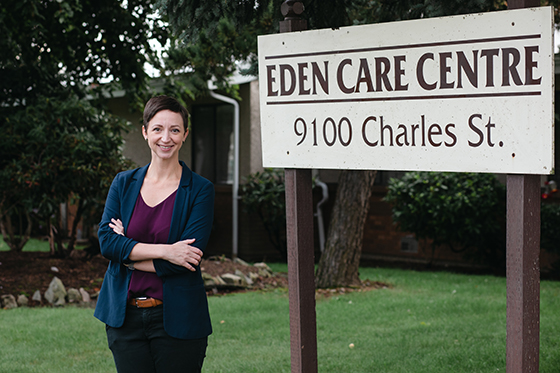People living in long term care (LTC) facilities are more likely to enjoy better health outcomes and avoid emergency room visits when they have access to a dedicated physician who can observe, manage and coordinate their medical needs in a consistent and timely fashion.
It’s why the GPSC launched its Long-Term Care Initiative (LTCI) in 2015 as a partnership with Doctors of BC, the Ministry of Health, divisions of family practice, health authorities and long-term care facilities. Since then, the partners have been working together to design community-based solutions that aim to see every person living in a LTC home assigned a most responsible provider (MRP) – typically a family doctor or nurse practitioner.
Their efforts are making a difference. A 2020 service review shows that 96 per cent of BC’s long-term care facilities representing 31,000 beds are participating in the LTCI, and are able to routinely reach a MRP after hours more than 85 percent of the time. This is a significant increase from 2015. Most notably, unscheduled transfers of people from long-term care homes to emergency departments have substantially decreased.
Each community is taking a unique approach to develop effective local solutions. As an example, Chilliwack is using a ‘cluster model’ for their LTCI work in six facilities in Chilliwack, two in Agassiz, and one in Hope. The facilities are small to medium in size, and the largest facility has 100 beds.
The Chilliwack LTCI was initially headed by Dr. Erin Lynch.
“There was a lot of involvement from physicians and it was very much a group decision – a very collaborative effort,” she says.
She explains that about 50 per cent of people in LTC have their own family doctor. “For others, we agreed on using a cluster model. The cluster model has physicians who work in LTC facilities take on a number of unattached patients; usually 10 to 20 patients.”
Currently, every person in LTC has an MRP assigned to them, either from the cluster group, or their own family doctor.
The cluster model’s positive impact was reinforced during the first wave of the pandemic. In Chilliwack, it enabled a small group of dedicated LTC physicians to cover all facilities with twice-weekly proactive visits during this critical time, mainly through in-person visits with some virtual check-ins. Changes in care needs were promptly addressed while nurses had greater physician access with more robust team-based care.
Dr Dara Donnelly is the LTCI’s current physician lead in Chilliwack.
“What pleases me most is the intention of the LTCI – to provide more proactive care, try to reduce ER visits/transfers and reduce medications when appropriate,” she notes. “It all leads to better quality of life. Under this model, the Chilliwack, Agassiz and Hope region demonstrated large improvements for ER transfers and admissions.”

(Photographed above: Dr Dara Donnelly)
Many facilities have the capacity to do minor procedures such as stitches to help avoid the need for an ER visit, and every facility is set-up to replace catheters. The provision of a 24/7 dedicated call schedule simplifies physician access for staff while a mandate to run all potential hospital transfers past the physician on-call has reduced the number of transfers. If it is not possible to avoid the ER, the physician will connect with the ER to expediate a visit.
As an example, a person living with dementia and who paced to manage restlessness fell on a Saturday. To avoid an ER visit, the physician on-call arranged for her to have a same-day x-ray, and then return to the LTC facility. The x-ray confirmed the broken hip and arrangements were made for an elective admission for an operation the next day. She was able to spend the night at home in her facility, where she had pain relief and was cared for by staff who knew her and her behavioural needs. The next day, she was admitted directly to the orthopedic ward, had her operation a few hours later and was discharged home within two days.
Ultimately, she received most of her care in her residence with people she knew, reducing her stress and aiding her recovery. The action ensured that this senior would have the best opportunity to maintain her quality of life while reducing her risk of delirium and other complications.
To continue providing 24/7 coverage, the cluster model is expanding to include more nurse practitioners.
“Our seniors are more medically complex,” says Dr Donnelly. “The degree and means of family involvement have changed. The demands LTC puts on physicians has certainly evolved with changing pressures. The way we support LTC needs to respond – we must have the capacity, people and resources to support our seniors and their families in the things that matter to them. We can do so much by focusing on the person rather than algorithms and medications – I tend to consider it heavier on art than science.”
Dr Donnelly is part of a new GPSC LTCI Task Group that will further advise and oversee implementation of recent recommendations gathered through the LTCI service review. The task group includes a variety of long-term care physicians, nurse practitioners, divisions of family practice, family caregivers, and regional health authorities, with additional engagement with First Nations Health Authority and LTC advisors.
This work is funded through the GPSC, a partnership of Doctors of BC and the Ministry of Health.
For more information, see:
